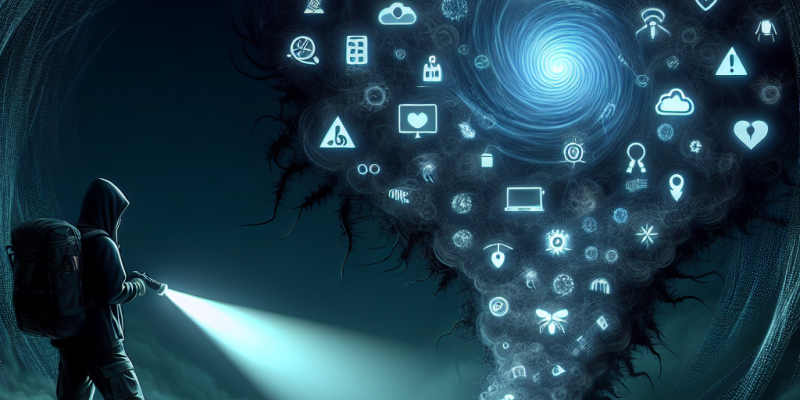Navigating the Dark Web: Understanding Cyber Threats from the Shadows

In the vast expanse of the internet, we often hear of the so-called "Dark Web," a mysterious and often misunderstood segment lurking beneath the surface of the World Wide Web. Unlike its more innocuous counterpart, the Deep Web—which consists of databases, private documents, and content not indexed by conventional search engines—the Dark Web represents a clandestine realm where anonymity reigns supreme. This shadowy dimension has garnered a reputation as a hotspot for illicit activity, cyber threats, and emerging technologies, making understanding it more important than ever.
What is the Dark Web?
The Dark Web refers to portions of the internet that have been intentionally hidden and are inaccessible through standard web browsers. Accessing this hidden internet typically requires specialized software, most commonly the Tor browser, which uses a technique known as onion routing to encrypt the user’s data and anonymize their online activity. While the Dark Web hosts legitimate users seeking privacy and security from surveillance, it is equally infamous for activities that often border on the illegal.
Perception vs. Reality
The public perception of the Dark Web is often skewed toward its criminality. Popular media sensationalizes tales of drug trafficking, human trafficking, arms sales, and other nefarious activities, leading to a simplified worldview that the Dark Web is merely a haven for criminals. However, this narrow perspective belies the true nature of this hidden network. In reality, individuals leverage the Dark Web for various reasons, including:
- Political dissent: Journalists, activists, and whistleblowers in oppressive regimes use the Dark Web to communicate safely and share information without fear of retribution.
- Data privacy: Users concerned with surveillance and data privacy opt for the Dark Web to maintain their anonymity.
- Research and education: Some academics and professionals study the Dark Web to understand cyber threats and inform cybersecurity measures.
Cyber Threats Born from the Shadows
Despite the legitimate uses of the Dark Web, it’s crucial to recognize the heightened risks and threats emanating from this unregulated space. Here are some prevalent cyber threats that arise from Dark Web activity:
1. Illicit Marketplaces
Dark Web marketplaces operate similarly to online marketplaces but deal exclusively in illegal goods and services. Users can purchase everything from drugs and counterfeit currency to hacking services and illegal firearms. These marketplaces often feature customer reviews and ratings, creating a false sense of trustworthiness, while simultaneously posing risks to unsuspecting buyers, including scams and law enforcement operations.
2. Stolen Data and Credentials
Hacker forums on the Dark Web are rife with discussions about data breaches and the sale of stolen login credentials, personal identification information (PII), and financial information. Cybercriminals frequently obtain data through phishing attacks, malware, and data breaches, which they sell on these forums at a fraction of its value, exposing individuals and organizations to identity theft and fraud.
3. Ransomware as a Service
Ransomware attacks have become alarmingly common, with cybercriminals utilizing Dark Web platforms to offer ransomware as a service to less-experienced hackers. This model includes payment facilitation, customer support, and even marketing, making it easier for perpetrators to launch attacks against targets ranging from small businesses to large corporations.
4. Advanced Cyber Attacks
The Dark Web also serves as a breeding ground for sophisticated cybercriminal networks. These entities share advanced tools and techniques, making it easier for novice attackers to execute cyberattacks. Malware kits, botnets, and distribution channels proliferate in this space, giving rise to increasingly serious threats to cybersecurity.
Staying Safe in a Complex Digital Landscape
Awareness is the first step toward safeguarding oneself from the threats posed by the Dark Web. Here are critical best practices for individuals and organizations:
-
Education and Training: Understanding cyber threats is essential. Regular training sessions should be conducted to educate employees about the dangers lurking in the digital realm and how to recognize warning signs.
-
Data Protection: Use robust security measures, such as multi-factor authentication and regular password updates. Encrypt sensitive data to protect against breaches.
-
Monitoring Online Activity: Regularly monitor systems and networks for unusual activity. Employ cybersecurity tools that can detect anomalies indicative of potential breaches.
- Risk Assessment: Conduct thorough assessments of potential vulnerabilities and develop incident response plans to mitigate the impact of a successful attack.
Conclusion
The Dark Web may be perceived as a black hole of crime and danger, but it is essential to recognize the multifaceted nature of this hidden realm. While it hosts a spectrum of illicit activities and cyber threats, it also serves as a refuge for those seeking privacy and freedom of expression. By understanding the Dark Web’s complexities and potential threats, individuals and organizations can developively safeguard themselves in an increasingly digital world where online safety remains paramount. Empowering ourselves with knowledge is the best defense against the shadows that linger on the internet’s fringe.














